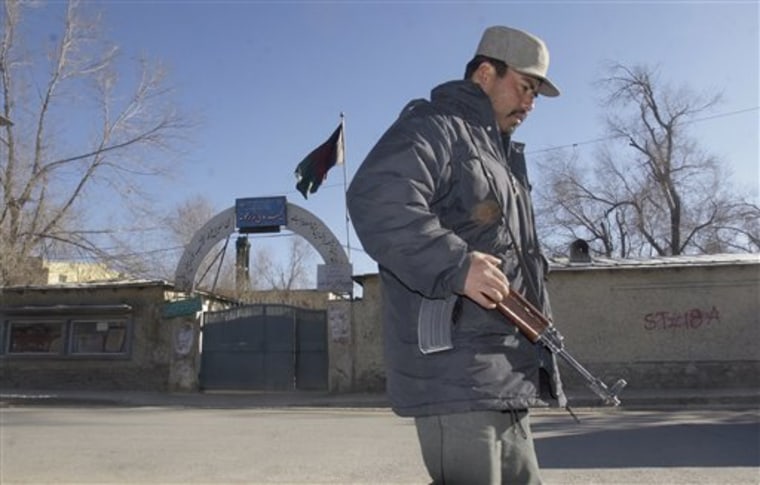The number of students and teachers killed in Taliban attacks has tripled in the past year in a campaign to close schools and force teenage boys to join the Islamic militia, Afghanistan's education minister says.
While the overall state of Afghan education shows improvement, Education Ministry numbers point to a sharp decline in security for students, teachers and schools in the south, where the Taliban thrives.
The number of students out of classes because of security concerns has hit 300,000 since March 2007, compared with 200,000 in the previous 12 months, while the number of schools closing has risen from 350 to 590.
The Taliban strategy is deliberate: "to close these schools down so that the children and primarily the teenagers that are going to the schools — the boys — have no other option but to join the Taliban," Education Minister Mohammad Hanif Atmar said in an interview Tuesday.
The Taliban know that educated Afghans won't join the militants, so a closed school leaves students with two options — join the Taliban or "to cross the border and go into those hate madrassas," Atmar said, referring to Islamic seminaries in Pakistan where "they will be professionally trained as terrorists."
Wakil Ahmad Khan, a top official at Pakistan's religious affairs ministry, said Pakistani "madrassas are doing a wonderful job by providing education to millions of students" and "if the Afghan officials have any such information, they should share it with Pakistan's Foreign Ministry."
Community defense initiative
Attacks on schools still in operation have actually fallen in the past 10 months to 98 from 187 in the same period of 2006, Atmar said. Atmar attributed the drop to a community defense initiative. But the Taliban have switched to targeting students on their way to and from school or in other places where they congregate.
The U.N. said it couldn't confirm that Taliban fighters were upping efforts to recruit schoolboys, and no educational aid organizations that could confirm Atmar's claims are working in provinces such as Helmand in the dangerous south.
Adam Rutland, a spokesman at the British reconstruction team in Helmand province, said the perception in Helmand province was that more schools were open than in the past, although he added that it's well known that disaffected and poor young men are a recruiting base for the Taliban.
Atmar said 147 students and teachers have been killed in Taliban attacks since mid-March, compared with 46 in the previous year. The 147 include 58 students and teachers killed in a single bombing and gunfire attack in Baghlan province in November.
The number of students and teachers wounded has gone from 46 to 200, he said.
Students seek education elsewhere
Most of the schools closed for security reasons are in the south. In Helmand, the world's largest opium poppy growing region, 177 schools are closed, along with 150 in nearby Kandahar province, Atmar said.
He said dozens of students he talked with in Helmand province recently told him the Taliban are pushing them to enlist. Some 1,100 students from outlying areas are traveling to the relative safety of the Helmand provincial capital of Lashkar Gah to attend class. Atmar said he hopes soon to provide housing and food for these students.
Of the 13 districts in Helmand, seven have no schools in operation, said Sayed Abrar Agha, the director of education in Helmand. District leaders like Agha provide the figures that Atmar cites.
Agha said he recently visited the town of Musa Qala — which was controlled by the Taliban until last month — and the head education official refused to talk to him.
"He's still afraid of the Taliban and doesn't want to meet with government officials," Agha said.
Atmar predicted attacks on students and teachers would continue to increase unless the international community and the Afghan government delivered protection.
Still, overall there is positive news in Afghanistan's educational comeback since the days of the Taliban, when girls couldn't attend schools and fewer than 1 million boys did. Some 5.8 million students now attend class, up from 5.4 million a year ago, 35 percent of them are female, Atmar said.
The Education Ministry's goal is that within four years 75 percent of all boys will be in classes — up from roughly 50 percent currently — and 60 percent of all girls — up from less than 30 percent today.
Schools also suffer from a shortage of qualified teachers, particularly female ones, and of infrastructure.
Linking up with Western schools
U.S. forces in the eastern province of Kunar are linking Afghan children with schools in the U.S., Italy and Germany that can supply pens, notebooks and chalk, the military said Wednesday.
"Being in the U.S., it is hard to visualize the lack of resources they have here," Army Capt. Jay S. VanDenbos, 30, from Tahlequah, Okla., was quoted as saying in a military news release.
Teachers are underpaid, and of Afghanistan's 9,400 schools, only 40 percent have proper facilities, he said. "Ninety percent of the schools are open-air schools, which are sometimes a tarp and a dirt floor. They'll have a rock that they use as a chalk board, and kids sit underneath the tarp and learn."
"Most of the kids want to learn. They yearn for knowledge," said VanDenbos. "Anytime anyone goes on patrols, the kids are screaming to 'give me pen, give me pen.'"
